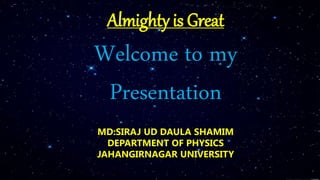
Magnetic field, Rotational curve, mass, Luminosity of Milky Way Galaxy
- 1. Almighty is Great MD:SIRAJ UD DAULA SHAMIM DEPARTMENT OF PHYSICS JAHANGIRNAGAR UNIVERSITY Welcome to my Presentation
- 2. Contents Mass of milky way galaxy Luminosity distribution of galaxy Magnetic field of our galaxy Rotational curve of galaxy
- 3. Mass of the Milky Way Galaxy There are multiple ways of determining the mass of a galaxy: By Luminosity: One way is to measure the luminosity of the entire galaxy , then determine the mass of the galaxy. This method can’t measure the mass of invisible matter, like Black Holes. By Gravity: Another way is to use gravity to measure mass, since all the matter in the universe is expected to interact gravitationally. Using this method, we should be able to measure the mass of objects even if they are invisible to our eyes by their effects on nearby objects.
- 4. Luminosity Distribution of Galaxies In astronomy, luminosity is the total amount of energy emitted by a star, galaxy, or other astronomical object per unit time. In 1930 ,Hubble investigated the luminosity distribution in elliptical galaxies and expressed the distribution law as, I(r) = 𝐼0 ( 1+ 𝑟 𝑎 )2 Where, 𝐼0 refers to the central intensity and a is the solar constant. The luminosity of the Milky Way galaxy according to this is 5×10^36 Watts .
- 5. In general the mass luminosity ratio is assumed to be constant for any particular galaxy , in order to determine the mass distribution from the observed luminosity distribution. For stars on the main sequence, luminosity is also related to mass: L⊙ = solar luminosity Hertzsprung –Russell diagram Mass-Luminosity Relation
- 6. Luminosity and Mass vs Distance The visible light from stars we observe suggests that the majority of the mass of the Milky Way should be concentrated near the center. Looks bright at center so most the mass should be at the center. Distance from the Galactic Center Lightfromstars Distance from the Galactic Center Mass
- 7. Estimates of the mass of the Milky Way vary, depending upon the method and data used. Avarage the mass of the Milky Way is 5.8×1011 solar masses (M☉), The total mass of all the stars in the Milky Way is estimated to be between 4.6×1010 M☉ and 6.43×1010 M☉. In addition to the stars, there is also interstellar gas, comprising 90% hydrogen and 10% helium by mass, The mass of this gas is equal to between 10% and 15% of the total mass of the galaxy's stars. Interstellar dust accounts for an additional 1% of the total mass of the gas. Mass of the Milky Way Galaxy
- 8. Magnetic Field of Milky Way Galaxy
- 9. Magnetic Field of Milky Way Galaxy The main magnetic field structure lies in the plane of the disc and follows the spiral arm. . The arrows indicate the direction of the magnetic field, assumed to lie along spiral arms. The axisymmetric model derived from polarization surveys and rotation measures of extragalactic sources The red arrows are in the opposite direction to the black ones i.e the magnetic fields is reverse.
- 10. The bisymmetric model of the large-scale structure of magnetic fields in the Milky Way disk, derived from pulsar rotationmeasure The arrows indicate the direction of the magnetic field, assumed to lie along spiral arms. The locations of the Sun and the Galactic Center (GC) are indicated on the model.
- 11. Rotation Curve of the Milky Way Galaxy
- 12. Solid Body Rotation Curve Example: Merry-Go-Rounds • Every part of the merry-go-round “orbits” the center in the same amount of time – Inner part moves slow – Outer part moves fast Merry-Go-Rounds
- 13. Keplerian Rotation Curve Example: Our Solar System The period of each planet depends on its distance from the Sun – Kepler’s 3rd Law: P2 ∝ a3 – Planets farther away form the sun go much slower.
- 14. The Milky Way Galaxy’s Rotation Curve The rotation curve of a disc galaxy (also called a velocity curve) is a plot of the orbital speeds of visible stars or gas in that galaxy versus their radial distance from that galaxy's centre.
- 15. However the flat rotation curve tells a different story? Because there is a flat rotation curve there should be an equal amount of mass distributed everywhere throughout the galaxy’s disk and halo. Distance from the Galactic CenterMass Mass curve determined from Light Mass curve determined from the rotation curve
- 16. So which mass curve is right? The mass curve determined from the rotation curve is our current best model for how the mass of the galaxy is distributed. Mass evenly distributed everywhere in the disk and halo. But that is a problem. Where is all the missing mass and why can’t we see it? Distance from the Galactic Center AmountofMass Mass curve determined from Light Mass curve determined from the rotation curve
- 17. Where is the missing Mass? Dark matter – massive objects (matter) that are (is) distributed evenly around the galaxy in both the halo and disk.
- 18. Dark Matter • All galaxies exhibit the same problem of “missing” matter • Dark Matter • Does not emit light • Not mysterious or evil matter, just not seen • Possibilities: Brown Dwarfs, Neutrinos, Black holes, MACHOS, WIMPS We can not see 70-90% of the matter that makes up our Galaxy!! Vera Rubin Discoverer of Dark Matter
- 19. Comparison
- 20. That’s all, Thanks everyone for attention.
